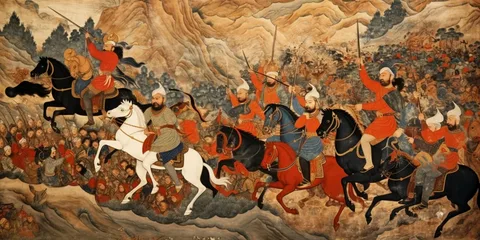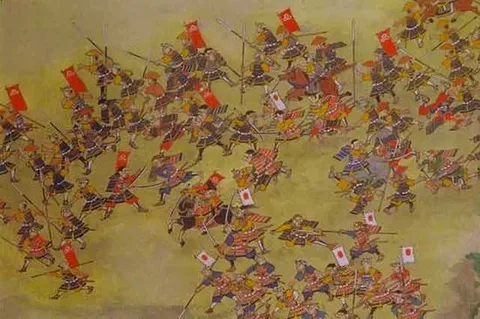The Battle of Bani Lehyan (6 Hijri) was a significant military expedition led by the Prophet Muhammad (peace be upon him) in the early years of Islam. It took place in the year 6 AH (627 AD), specifically during the months of Rabi’ al-Awwal or Jumada al-Awwal according to historical sources. This battle was principally a response to a grave act of betrayal and killing of ten Muslim companions by the Bani Lehyan tribe in a previous incident known as the Expedition of Al Raji, which occurred near Mecca.
The Battle Of Bani Lehyan
The Bani Lehyan tribe inhabited an area deep in the heart of the Hijaz region, near the borders of Mecca. They were a branch of the Adnanite tribes who had migrated from Mecca to settle in northern Arabian Peninsula. The roots of the conflict trace back to the Expedition of Al Raji, where ten Muslim envoys sent on a reconnaissance mission under the Prophet’s guidance were ambushed and killed by the tribe despite assurances of safety. Some companions, like Aasim ibn Thabit and Khalid ibn Al-Bukair, fought bravely until they were martyred, while others were captured, sold to the Quraysh, and then killed as retaliation for Quraysh losses.
The killing of the Muslim companions was considered a heinous betrayal of trust and a break of covenant, which demanded retribution. However, ongoing challenges such as the Battle of the Trench delayed any immediate response by the Muslims. After the confederate forces allied against the Muslims weakened and disintegrated, the Prophet seized the opportunity to retaliate and assert the growing military power of the Muslim community.
Read about: The battle of Bani Qurayzah (5 Hijri)
The March and Military Strategy

In 6 AH, the Prophet set out with around 200 Muslim fighters, including 20 cavalrymen, from Medina toward the territory of Bani Lehyan. To conceal his actual destination and avoid detection by enemy spies, the Prophet initially made a feint by heading towards Syria. After reaching the area known as Al-Batrah, he turned south toward the Batn Gharran valley—the site of the previous massacre.
The Muslims reached Batn Gharran and stayed there for two days. The Prophet prayed for the martyrs who had been killed in the earlier expedition and sought divine mercy and forgiveness for them. Upon learning of the Muslims’ approach, the Bani Lehyan tribe fled to the nearby mountains, evading direct confrontation and capture.
On the return journey, the Prophet sent a detachment of ten horsemen, led by Abu Bakr As-Siddiq, to Kura’ Al-Ghamim, a valley near Mecca. This move was strategic: it sent a message to the Quraysh that the Muslims could project military power close to their territory, instilling fear and demonstrating growing strength. The raiding unit’s presence near Mecca symbolized a psychological and tactical advance, signaling possible future offensives.
The entire expedition lasted for approximately fourteen days from the departure until the return to Medina, during which the Muslims remained vigilant despite the absence of a major battle or direct military engagement with the enemies.
Read more: The battle of Domat-Ul-Gandal (5 Hijri)
Results and Significance
Though the Bani Lehyan tribe avoided direct battle by retreating to the mountains, the expedition had multiple significant outcomes. First, it fulfilled the moral and religious imperative of avenging the treacherous killing of the Muslim companions in Al Raji. The Prophet’s response underscored the seriousness of betrayal and the sanctity of Muslim lives, sending a strong message to all tribes in Arabia about the consequences of violating treaties and agreements with Muslims.
Secondly, the expedition strengthened Muslim morale and demonstrated the increasing military capabilities of the Islamic state. The operation projected Muslim power much deeper into hostile territories than before, which helped in shaping alliances, intimidating adversaries, and consolidating the Muslim presence in the Arabian Peninsula.
Finally, this campaign showcased the Prophet’s wise leadership and strategic planning, particularly the successful use of deception and calculated military maneuvers to achieve psychological domination without large-scale bloodshed.
Recommend: The battle of Hamraa’ Al-Asad (3 Hijri)
FAQs
What caused the Battle of Bani Lehyan?
The battle was caused by the treacherous killing of ten Muslim companions by the Bani Lehyan tribe during the Expedition of Al Raji, which demanded retribution from the Muslim community.
When did the Battle of Bani Lehyan take place?
It took place in the year 6 Hijri (627 AD), around the months of Rabi' al-Awwal or Jumada al-Awwal.
Did the Muslims fight a major battle in the expedition?
No, the Bani Lehyan tribe fled to the mountains avoiding direct combat, so no major battle occurred during the expedition.
What was the significance of sending horsemen towards Mecca?
Sending ten horsemen near Mecca (Kura' Al-Ghamim) was a strategic move to intimidate the Quraysh and demonstrate Muslim military reach near enemy territory.
How long did the expedition last?
The entire expedition lasted about fourteen days, from departure to return to Medina.
Conclusion
The Battle of Bani Lehyan in 6 Hijri was an important expedition for the early Muslim community led by the Prophet Muhammad. It was motivated by the need to seek justice for the betrayal and killing of Muslim envoys and companions. The campaign highlighted the strategic prowess of the Prophet, emphasized the sacredness of trust and loyalty in Islam, and reinforced the growing strength of the Muslim state in Arabia. Although the tribe avoided direct battle, the expedition left a lasting impression, demonstrating that betrayal against Muslims would be met with decisive responses. It played a crucial role in advancing Muslim influence and securing the loyalty of Arabian tribes in the pivotal years of Islamic expansion.

